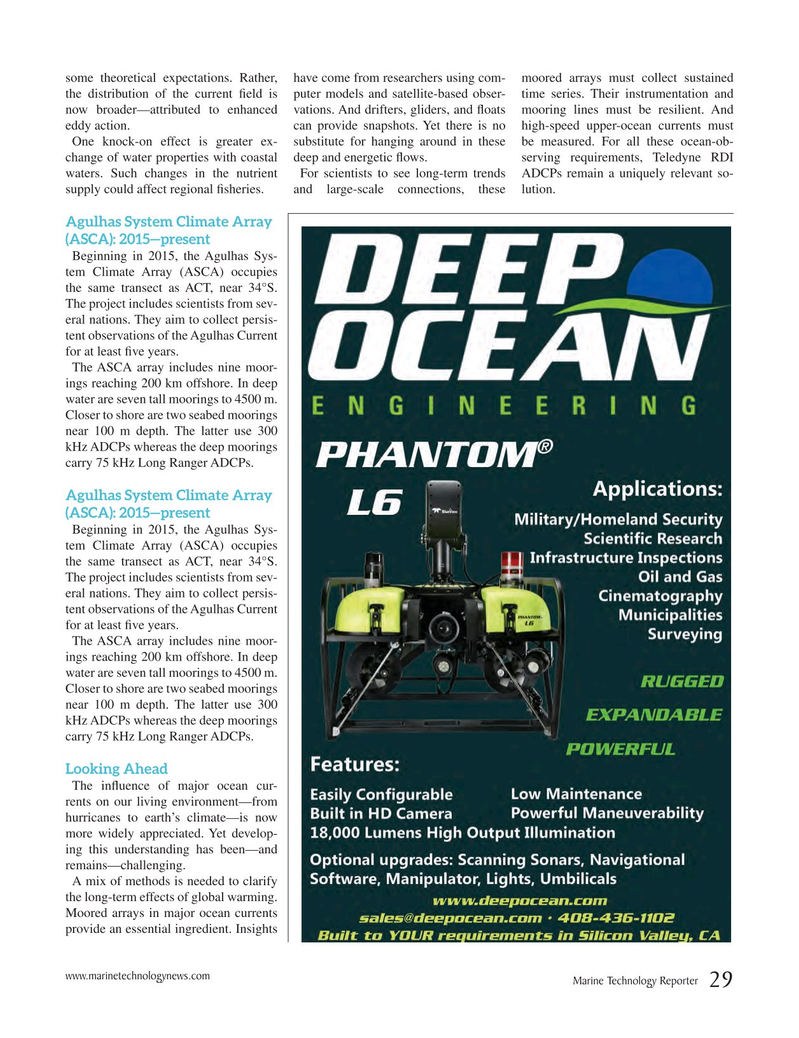
Page 29: of Marine Technology Magazine (October 2018)
Ocean Observation: Gliders, Buoys & Sub-Surface Networks
Read this page in Pdf, Flash or Html5 edition of October 2018 Marine Technology Magazine
some theoretical expectations. Rather, have come from researchers using com- moored arrays must collect sustained the distribution of the current ? eld is puter models and satellite-based obser- time series. Their instrumentation and now broader—attributed to enhanced vations. And drifters, gliders, and ? oats mooring lines must be resilient. And eddy action. can provide snapshots. Yet there is no high-speed upper-ocean currents must
One knock-on effect is greater ex- substitute for hanging around in these be measured. For all these ocean-ob- change of water properties with coastal deep and energetic ? ows. serving requirements, Teledyne RDI waters. Such changes in the nutrient For scientists to see long-term trends ADCPs remain a uniquely relevant so- supply could affect regional ? sheries. and large-scale connections, these lution.
Agulhas System Climate Array (ASCA): 2015—present
Beginning in 2015, the Agulhas Sys- tem Climate Array (ASCA) occupies the same transect as ACT, near 34°S.
The project includes scientists from sev- eral nations. They aim to collect persis- tent observations of the Agulhas Current for at least ? ve years.
The ASCA array includes nine moor- ings reaching 200 km offshore. In deep water are seven tall moorings to 4500 m.
Closer to shore are two seabed moorings near 100 m depth. The latter use 300 kHz ADCPs whereas the deep moorings carry 75 kHz Long Ranger ADCPs.
Agulhas System Climate Array (ASCA): 2015—present
Beginning in 2015, the Agulhas Sys- tem Climate Array (ASCA) occupies the same transect as ACT, near 34°S.
The project includes scientists from sev- eral nations. They aim to collect persis- tent observations of the Agulhas Current for at least ? ve years.
The ASCA array includes nine moor- ings reaching 200 km offshore. In deep water are seven tall moorings to 4500 m.
Closer to shore are two seabed moorings near 100 m depth. The latter use 300 kHz ADCPs whereas the deep moorings carry 75 kHz Long Ranger ADCPs.
Looking Ahead
The in? uence of major ocean cur- rents on our living environment—from hurricanes to earth’s climate—is now more widely appreciated. Yet develop- ing this understanding has been—and remains—challenging.
A mix of methods is needed to clarify the long-term effects of global warming.
Moored arrays in major ocean currents provide an essential ingredient. Insights www.marinetechnologynews.com
Marine Technology Reporter 29
MTR #8 (18-33).indd 29 MTR #8 (18-33).indd 29 10/1/2018 2:20:37 PM10/1/2018 2:20:37 PM

 28
28

 30
30
